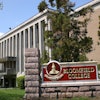Part I
WASHINGTON — Despite a nascent economic recovery, education advocates, policymakers and other leaders continue to sound concerns over U.S. higher education’s long-term viability and productivity.
Foremost among current worries is the financial stability of colleges and universities, particularly now that federal stimulus support has dried up.
Even while President Obama talks about boosting U.S. college completion rates to increase the nation’s global competitiveness, private and public institutions continue to struggle economically.
On March 18, Diverse: Issues in Higher Education convened an expert panel to answer the question “How Can Higher Education Solve its Financial Problems?” Diverse co-founder Frank Matthews and former Diverse editor Toni Coleman moderated a nearly two-hour roundtable discussion among seven panelists held at the headquarters of the Association of Public and Land-grant Universities (APLU) in downtown Washington, D.C.
While its theme centered on higher education’s financial health, the wide-ranging conversation touched upon issues as varied as the institution accountability movement, federal involvement in higher education and the future of minority serving institutions.
Participants were Lezli Baskerville, president and CEO, National Association for Equal Opportunity in Higher Education; Kevin Carey, policy director, Education Sector; Dr. Lorenzo Esters, vice president, Office for Access and the Advancement of Public Black Universities, APLU; Steve Graubart, managing director of finance, University of the District of Columbia; Dr. Marshall Grigsby, president, Grigsby and Associates, LLC; Cheryl Hitchcock, vice president of institutional advancement, Morgan State University; and Jane Wellman, executive director, Delta Project on Postsecondary Costs, Productivity and Accountability. The following are highlights from the discussion:
Diverse: What are some of the more innovative strategies that you have seen college leaders develop and implement in response to the recession?
LORENZO ESTERS: I would just say two things. I think the one thing we’ve learned from the economic downturn is that entrepreneurial leadership is extremely important, perhaps more important today than any time in recent history. Particularly as we see the decrease in state funding, it is important that institutions should be working with foundations more, be more competitive with grants and some of the nontraditional sources of funding. The other thing we have to do is ensure that our institutions are being responsive to the workforce needs. It is important for institutions to review institutional and academic programs to ensure that we are providing programs that are in high demand.
JANE WELLMAN: I think we are seeing much more attention to the need to restructure academic programs than we’ve ever seen before. The evidence of how bad it is hasn’t yet bubbled up as much as it needs to. I think this is serious. The work that’s being done on the administrative side — like purchasing, like how we’re dealing with energy costs — is pretty deep. There is a lot of money that’s being found in improvements in services and efficiencies. Academic program restructuring is pretty serious. It’s not just about cutting budgets. It’s about reinvesting and finding ways to generate resources to put into those places that are going to make a difference in academic performance.
MARSHALL GRIGSBY: These are challenging times for higher education in general, certainly for institutions that are under-resourced and institutions that began so far behind in terms of the funding from state, federal and private sources. But even in the midst of all those challenges, our institutions have been resilient. They are, they have been and, I suspect, will continue to be resilient because they’ve continued to have people with tremendous capacity and vision at the helm. So I’m down about some of the current things we face but not in terms of the long term because of the track record.
Diverse: Describe the impact of state budget cuts on public institutions?
JANE WELLMAN: [There will be] less money in the near term for almost all public institutions. The magnitude of funding reductions affecting public institutions across the country this year is unlike anything we’ve seen before. We have a double or triple whammy going on. One of them is the continuing decline of state resources for higher education. States are directing more of their resources to corrections, health care and to other areas that don’t pay off in social investments. That’s made worse because of the depth of this recession and the slow recovery. State budgets typically recover two or three years after national recovery. Revenues are barely flat, if not continuing to decline, in the majority of states. Added to that, of course, is the disappearance of federal stimulus funds. And then on top of that, unprecedented levels of enrollment demand by students. So I guess that’s a quadruple whammy: student demand, disappearing federal subsidies, a very tough recession and eroding state funds. I don’t think anyone who looks at public funding for higher education concludes that the situation is likely to turn around any time soon.
KEVIN CAREY: I think Jane is very frank in saying that this economic crisis is very different than the last couple. The 1991 recession and the 2000-2001 recessions were very mild. There was a lot of hue and cry at the time about budget cuts, and higher education took a hit as it tends to; but, if you just look at the raw numbers, the money came back. Campuses hadn’t really had to make very painful decisions. This is different. This recession is much worse. The reaction from states is much different. I feel like this time it’s serious, and so campuses will have to tackle faculty productivity in a way that they were able to avoid previously. The most successful campuses will take the opportunity created by this crisis to restructure their personnel costs in smart, constructive ways — not in a ‘just let the number of tenured faculty continue to shrink and hire more adjuncts for no money’ kind of way. I think a better structure is probably one where you have a more stable cadre of well-compensated scholars, and then around that, depending on the needs of the students and the dictates of their classrooms, a combination of contingent faculty and, increasingly, technology. But you do that in a deliberate way. You don’t do it in a response to crisis way.
CHERYL HITCHCOCK: First of all, as you can imagine, all eyes turn to the development office when the state cuts budgets. With a lot of the public universities, such as my own, fundraising is still relatively new for most of us because for years we didn’t have to. Private universities had been doing it all along. We had our first capital campaign in 2007. And as far as our peer institutions, we were on the leading edge on that. More than 90 percent of our students are on some type of financial assistance. Most of our fundraising has been for scholarships and need-based financial aid. As tuitions go up, our students have to work to supplement their funds; and then by working, of course, that impacts their success in the classroom. Some of them drop out. Some of them stop out for a period of time to get more money.
Diverse: How do you see the struggles over public employee benefits in Wisconsin, Ohio and Indiana relating to higher education?
JANE WELLMAN: Well, let’s make sure I understand what you’re asking about. What’s happening in a number of states — Wisconsin, Ohio, Indiana — there’s been a significant attack, which I think is the right word, on public employees’ bargaining rights. But there’s also been significant steps taken to address one of the longtime funding problems in higher education, which is the growth in spending on benefits. I think that, as hard as it’s been, the consequences of action on employee benefits this year will be helpful to higher education. [It will be] painful, not fun. Nobody asked for it, but from a money perspective it had to happen. If you look at money in higher education, the single biggest area of growth has been in employee benefits. We either are going to have to cut if we’re going to maintain the benefit structures we have, or we’re going to pay for the next generation of students. There’s not enough money to do both.
KEVIN CAREY: I think Gov. (Scott) Walker overstepped in Wisconsin. He tried to push too far too fast and he’s actually created a political consolidation around certain kinds of employee rights that people have taken for granted for a long time. Six months from now, public employees might be in a stronger position because the public may have awakened to the idea that injustice was being served up to them. Personally, politically, I can share those feelings pretty strongly; but, at the same time, I’m also an education analyst. There is a need to rethink some of these old-held labor arrangements. Tenure is tricky, particularly in higher education with the very real and increasing influence of politics and corporations over academic freedom.





















